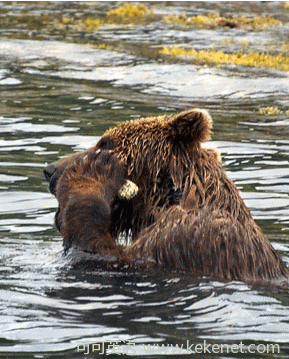(单词翻译:单击)

Science and Technolgy.
科技。
Animal behaviour.
动物习性。
Smarter than the average bear.
一只特别聪明的熊。
The first case of ursine tool use.
第一只会用工具的熊。
PRIMATES apart, few mammals employ tools. Sea otters use rocks to smash clams open, dolphins wrap sponges around their noses to protect themselves while they forage on the seabed, elephants swat insects with branches and humpback whales exhale curtains of bubbles to trap schools of fish. Until now, these four examples had been thought the extent of the non-primate mammalian tool-users club. But a study just published in Animal Cognition, by Volker Deecke of the University of St Andrews, in Britain, has added a fifth and rather surprising one. That epitome of rugged wildness, the grizzly bear, seems to be the only species other than humans to have invented the comb.
除了灵长类动物,会使用工具的哺乳类动物屈指可数。海獭会在石头上砸开蛤蜊;海豚在海床上觅食时,会将海绵绑在鼻子上以保护自身;大象会用树枝拍打昆虫;驼背鲸会呼出阵阵气泡来困住鱼群。至今,人们仍认为非灵长类动物中只有这四种会使用工具。但英国圣安德鲁大学的Volker Deecke在《动物认知》上刚发表的研究指出了第五种会用工具的动物,而且是令人相当意外的一种。粗犷野性的象征——灰熊,看来是除了人类以外唯一一种发明了梳子的动物。
Dr Deecke made this discovery while studying grizzly-bear behaviour from a small boat in Glacier Bay National Park, Alaska, on July 22nd 2010. After a period of play-fighting with another bear and a short bout of feeding on a beached whale carcass, a bear of between three and five years of age, sex unknown, waded into the shallows of the bay. Once there, it picked up a fist-sized rock and carefully rotated it for about a minute before dropping it back into the water. Moments later, it picked up another, of similar size, and again rotated it. This time, rather than discarding the stone, it held it against its muzzle and started to rub. Using its left paw to press the rock against its skin and its right paw to support the rock's weight, the bear rubbed away at its muzzle and face for roughly a minute before dropping the stone back into the water. Then it grabbed a third stone of the same size, rotated it and rubbed its face, muzzle and neck for a further two minutes before discarding it. This done, it spent two minutes grooming its right paw with its teeth before returning to the whale carcass.
这一点是Deecke博士于2010年7月22日在阿拉斯加冰河湾国家公园一艘小船上研究灰熊习性时发现的。一只灰熊(年龄3-5岁,性别未知)在与另一只熊打闹了一阵并吃了一点被冲到沙滩上的鲸鱼尸体后,涉水来到了海湾的浅滩中。在那,它捡起了一块拳头大的石头,小心翼翼地旋转了约一分钟后,将其扔回水中。片刻之后,它又捡起了另一块差不多大小的石头旋转起来。但这次它没扔掉石头,反而把石头放到口鼻处开始来回磨蹭。那只熊用左掌将石头按在皮肤上,用右掌托着石头,将石头在口鼻和脸上蹭了大约一分钟后才将石头扔回水里。然后,它捡起第三块同样大小的石头并在旋转后用来磨蹭脸、口鼻和脖子将近两分钟后将其扔掉。做完这些后,它又花了两分钟用牙齿来梳理右掌的毛,之后便回到鲸鱼尸体处。
Dr Deecke found, upon close examination of his photographs, that all three rocks were encrusted with barnacles and he reckons these were acting as the functional equivalent of the teeth of a comb. He thinks the bear was probably using its makeshift combs for comfort, rather than vanity. But crucially for the concept of tool-use, the animal's rejection of the first rock it picked up shows a discriminating understanding of what was required to get the right amount of scratching from a comb; which rock, in other words, was the tool for the job.
Deecke博士在仔细研究所拍照片后发现,那三块石头上都粘有藤壶,而他认为这些藤壶的功能梳齿一样。Deecke博士认为,那只熊自制梳子可能是想让自己舒服,而不是为了美观。但是,那只熊没有用它捡到的第一块石头,这说明它有能力判断子什么样的梳子才好用;换言之,就是哪块石头可以拿来当梳子。这一点对判断动物是否会使用工具至关重要。
An important question from a biological point of view is whether this animal's behaviour is unique. Other tool-using mammals are social species. That means one individual's chance invention is easily copied by others of its group, resulting in a primitive culture. Grizzly bears have not been considered particularly sociable in the past, but if others in Glacier Bay are seen combing themselves in this way that view might have to change. It might, though, be that Dr Deecke's preening animal is unique. That would suggest it came up with the idea of using rocks as combs by itself, rather than copying someone else-truly smarter than the average bear.
在此,有一个很重要的生物学问题:是不是只有这一只熊会使用工具?其他会使用工具的哺乳类动物都是群居动物,也就是说个体偶然的发明很容易被群体里的其他成员模仿,从而形成原始的文化。过去,人们并不认为灰熊具有明显的群居特征,但如果冰河湾有其他灰熊被发现使用这种方法梳理毛发,那上述观点就可能会被推翻。不过,也有可能只是Deecke博士看到的那只梳理毛发的熊比较特别罢了。那就意味着这只熊拿石头当梳子是自己的原创,并非模仿——果然是只特别聪明的熊。


